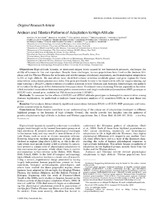Mostrar el registro sencillo del ítem
Andean and Tibetan patterns of adaptation to high altitude
| dc.contributor.author | Bigham, Abigail W | |
| dc.contributor.author | Wilson, Megan J | |
| dc.contributor.author | Julian, Colleen Glyde | |
| dc.contributor.author | Kiyamu, Melisa | |
| dc.contributor.author | Vargas, Enrique | |
| dc.contributor.author | León-Velarde, Fabiola | |
| dc.contributor.author | Rivera-Chira, María | |
| dc.contributor.author | Rodríguez, Carmelo | |
| dc.contributor.author | Browne, Vaughn A. | |
| dc.contributor.author | Parra, Esteban | |
| dc.contributor.author | Brutsaert, Tom D | |
| dc.contributor.author | Moore, Lorna G | |
| dc.contributor.author | Shriver, Mark D | |
| dc.date.accessioned | 2016-09-23T16:25:44Z | |
| dc.date.available | 2016-09-23T16:25:44Z | |
| dc.date.issued | 2013-01-24 | |
| dc.identifier.uri | http://repositorio.umsa.bo/xmlui/handle/123456789/8013 | |
| dc.description.abstract | Objectives: High-altitude hypoxia, or decreased oxygen levels caused by low barometric pressure, challenges the ability of humans to live and reproduce. Despite these challenges, human populations have lived on the Andean Altiplano and the Tibetan Plateau for millennia and exhibit unique circulatory, respiratory, and hematological adaptations to life at high altitude. We and others have identified natural selection candidate genes and gene regions for these adaptations using dense genome scan data. One gene previously known to be important in cellular oxygen sensing, egl nine homolog 1 (EGLN1), shows evidence of positive selection in both Tibetans and Andeans. Interestingly, the pattern of variation for this gene differs between the two populations. Continued research among Tibetan populations has identified statistical associations between hemoglobin concentration and single nucleotide polymorphism (SNP) genotype at EGLN1 and a second gene, endothelial PAS domain protein 1 (EPAS1). Methods: To measure for the effects of EGLN1 and EPAS1 altitude genotypes on hemoglobin concentration among Andean highlanders, we performed a multiple linear regression analysis of 10 candidate SNPs in or near these two genes. Results: Our analysis did not identify significant associations between EPAS1 or EGLN1 SNP genotypes and hemoglobin concentration in Andeans. Conclusions: These results contribute to our understanding of the unique set of adaptations developed in different highland groups to the hypoxia of high altitude. Overall, the results provide key insights into the patterns of genetic adaptation to high altitude in Andean and Tibetan populations. Am. J. Hum. Biol. 25:190–197, 2013. | es_ES |
| dc.language.iso | en | es_ES |
| dc.publisher | American Journal of Human Biology | es_ES |
| dc.subject | ALTURA | es_ES |
| dc.subject | ADAPTACIÓN A LA ALTURA | es_ES |
| dc.subject | ANDINOS Y TIBETANOS | es_ES |
| dc.title | Andean and Tibetan patterns of adaptation to high altitude | es_ES |
| dc.type | Article | es_ES |

